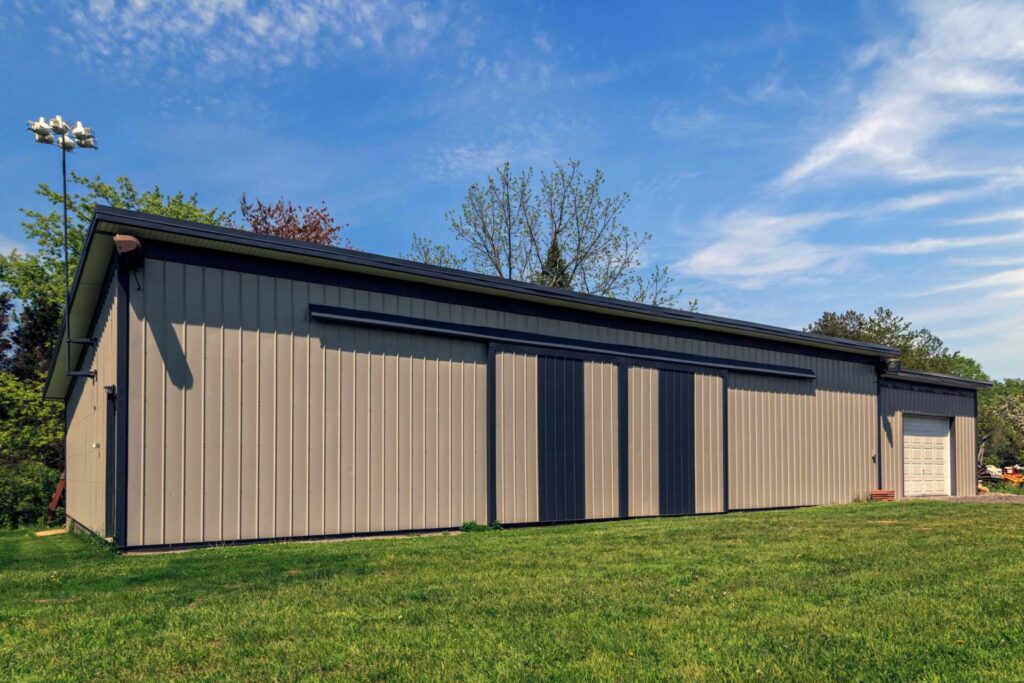
Contents
When it comes to steel structure budgets, understanding the intricate interplay of various factors is critical. From material costs to design complexities, each element has the potential to sway the financial landscape of your project. Labor expenses, site location considerations, and even maintenance costs all contribute to the bottom line. By unraveling the complexities of these key influencers, you can better navigate the path to a successful and cost-effective steel structure endeavor. But what are the specific nuances that can impact your budget the most?
Key Takeaways
- Material selection influences costs significantly.
- Design complexity affects material choices and expenses.
- Labor costs vary based on design intricacies.
- Geographic location impacts budget variations.
- Efficient maintenance plans optimize long-term expenses.
Material Costs
Material expenses have a substantial impact on the overall budget of steel structures, affecting project feasibility and financial stability. When considering material expenses, it’s essential to analyze the complexities of the supply chain and the dynamics of the global market.
The supply chain plays a central role in determining material expenses for steel structures. Understanding the various stages of the supply chain – from raw material extraction to manufacturing to delivery – is vital for cost estimation. Any interruptions in the supply chain can lead to price fluctuations, impacting the overall budget of a project. By closely monitoring the supply chain, you can identify potential risks and make informed decisions to mitigate them.
Moreover, the global market significantly influences material expenses for steel structures. Changes in global demand and supply, trade policies, and economic conditions of key steel-producing countries can all affect prices. Being aware of these factors and their potential effects on material expenses is essential for effective budget planning. By staying informed about global market trends and developments, you can adjust your budget strategies to navigate market uncertainties and ensure the financial sustainability of your steel structure projects.
Design Complexity
When considering the impact of design complexity on steel structure budgets, it’s important to acknowledge that structural requirements play a vital role in determining costs.
The design intricacies can lead to different material choices, directly influencing the project’s overall budget.
Moreover, the labor costs associated with implementing complex designs can greatly fluctuate, impacting the financial aspects of the construction process.
Structural Requirements Influence Costs
The complexity of structural design greatly impacts the budget for steel structures. When considering budget limitations, structural modifications to the design can have significant cost implications.
Customization options, while offering the opportunity to tailor the structure to specific needs, can also result in increased expenses.
Structural requirements play a pivotal role in determining the overall cost of a steel structure. A more intricate design that involves complex load-bearing calculations, unique architectural elements, or specific customization features will likely require more resources, time, and expertise to execute.
This heightened level of detail translates directly into higher costs due to the increased labor, materials, and engineering needed to bring such designs to fruition.
Therefore, when aiming to stay within budget constraints, it’s essential to carefully evaluate the structural requirements and consider the trade-offs between design complexity and financial considerations.
Material Choices Affect Budget
The selection of different materials significantly impacts the budget for steel structures. When pondering material options for your steel framework, it’s vital to weigh factors such as environmental impact and sustainability considerations.
Opting for eco-friendly materials may initially seem more costly, but they often lead to long-term cost savings through reduced maintenance and energy efficiency.
Furthermore, aesthetics and design preferences play a significant role in material selection. Materials with distinctive finishes or textures may come at a higher price but can add visual appeal to the structure, enhancing its overall design.
Balance is key when deciding on materials; while cost-effectiveness is important, it’s also essential to contemplate the long-term benefits and the influence of your choice on the environment.
Labor Costs Vary Widely
Labor costs for steel structures can vary widely based on the complexity of the design. Wage disparities play a significant role in determining these costs, as projects requiring specialized skills often command higher wages. Skilled labor is essential for intricate designs, but this expertise comes at a premium.
To ensure project efficiency, it’s vital to balance the need for skilled labor with cost-saving strategies.
Cost-saving strategies can include optimizing the design to minimize labor-intensive tasks, prefabricating components off-site to reduce on-site labor hours, and utilizing technology for accurate and swift construction processes.
By carefully planning the project timeline and workflow, contractors can mitigate potential delays and extra labor costs due to design complexities.
Understanding the impact of design complexity on labor costs is pivotal to managing budgets effectively. By investing in skilled labor where necessary and implementing efficient strategies, projects can strike a balance between quality and cost-effectiveness.
Site Location
When considering site location for a steel structure project, you should analyze the geographic cost variations. This analysis includes the accessibility to materials and the availability of local labor. These factors can have a substantial impact on your budget and overall project timeline.
Understanding how these elements interplay at the site location is vital for effective cost management and project execution.
Geographic Cost Variations
Considering geographic cost differences in site selection can have a significant impact on the overall budget of a steel structure project. Economic aspects play a vital role in determining the cost discrepancies across various geographical areas.
Industry patterns also influence these differences, as regions with high demand for steel structures may experience increased construction expenses. Additionally, construction obstacles unique to particular areas can increase costs, affecting the project’s budget considerations notably.
It is crucial to conduct comprehensive research on the economic environment of potential site locations to make well-informed decisions regarding budget allocation. Understanding the cost disparities in diverse regions allows for better planning and resource management.
By keeping up-to-date with industry patterns and anticipating potential construction challenges, project managers can lessen unforeseen expenses and ensure the project remains within budget constraints.
Therefore, when commencing a steel structure project, analyzing geographic cost differences in site locations is essential for successful budget management. Being mindful of economic aspects, industry patterns, and construction challenges specific to each location will help enhance budget considerations and improve project outcomes.
Accessibility to Materials
Exploring the proximity of material sources to the site location is important for maximizing budget efficiency in steel structure projects. The efficiency of the supply chain greatly impacts transportation costs, which are a significant factor in the overall budget. When material sources are located closer to the construction site, transportation costs decrease, positively impacting the project’s financial bottom line.
Analyzing the accessibility to materials involves evaluating the efficiency of the supply chain in delivering steel components to the construction site. A streamlined and well-organized supply chain ensures that materials are readily available when needed, reducing delays and additional costs. By minimizing transportation distances, projects can benefit from cost savings that contribute to budget optimization.
Transportation costs within the supply chain are essential for maintaining a competitive edge in the steel structure industry. Optimizing material accessibility enhances budget efficiency and ensures timely project completion. Thus, evaluating the proximity of material sources and the associated transportation costs is essential for successful steel structure projects.
Local Labor Availability
Analyzing the local labor availability at the site location is essential for optimizing budget efficiency in steel structure projects. When evaluating the labor market, take into account the wages offered to make sure they align with your project budget. It is essential to assess the availability of skilled workers in the area and the opportunities for training to meet project requirements effectively.
| Factors to Consider | Description | Importance Level |
|---|---|---|
| Labor Market | Evaluate the local labor market to determine the availability of workers and assess wage levels. | High |
| Skilled Workers | Assess the availability of skilled workers in the area to meet the project’s specific requirements. | High |
| Training Opportunities | Explore training programs and opportunities in the vicinity to enhance the skills of the local workforce. | Medium |
Labor Expenses
Labor expenses play a significant role in determining the overall budget for steel structure projects. When considering labor costs, two important factors come into play: the availability of a skilled workforce and the impact of union regulations.
Having access to a skilled workforce is essential for the successful and timely completion of steel structure projects. Skilled workers possess the necessary expertise to handle the complexities of steel construction, ensuring that the project meets high-quality standards. However, the availability of such a workforce can directly influence labor expenses. Areas with a shortage of skilled workers may require higher wages to attract talent, thereby increasing overall labor costs.
Union regulations also play a crucial role in shaping labor expenses for steel structure projects. Unionized labor forces often have standardized wage rates, benefits, and working conditions that must be adhered to, impacting the project’s budget. While these regulations can ensure fair treatment and safety for workers, they can also lead to higher labor costs due to negotiated agreements and additional benefits that unions provide.
Structural Requirements
Considering steel structure budgets, a key aspect to address is the adherence to specific structural requirements that heavily influence project costs. When it comes to foundation types, the choice between shallow foundations like spread footings or deep foundations like piles impacts the overall budget considerably. Shallow foundations are usually more cost-effective for smaller structures, while deep foundations are necessary for larger and heavier buildings.
Moreover, the selection of steel grades is pivotal as different grades have varying mechanical properties, affecting the material cost and structural integrity. Understanding the load-bearing capacity of the steel members is essential to ensure that the structure can support the intended loads without compromising safety. Additionally, seismic considerations are crucial in determining the design requirements to withstand potential earthquakes, impacting both material selection and construction techniques.
To provide a clearer overview, the table below summarizes key elements related to structural requirements that influence steel structure budgets:
| Structural Requirement | Impact on Budget |
|---|---|
| Foundation Types | Significant |
| Steel Grades | Material Cost |
| Load Bearing Capacity | Safety |
Permitting Fees
When evaluating steel structure budgets, factoring in permitting fees is essential as they directly impact the overall project cost. Construction regulations dictate that acquiring the necessary permits for your steel structure project is a critical step in ensuring compliance with local building codes and safety standards. Understanding the application process for permits is key to avoiding delays and unexpected costs during construction.
Permitting fees are determined based on the scope of the project, with larger or more complex steel structures often incurring higher fees due to the additional review required by regulatory authorities. It’s important to factor these costs into your budget from the outset to prevent budget overruns later on.
Additionally, familiarizing yourself with the specific construction regulations in your area can help streamline the permitting process and reduce the likelihood of facing fines or penalties for non-compliance.
Efficiently handling the application process for permits involves submitting detailed plans and specifications for your steel structure, along with any required documentation outlining how the project will adhere to relevant building codes. By proactively addressing permitting fees and requirements, you can better manage your budget and ensure a smoother construction process from start to finish.
Project Timeline
Efficiently managing the project timeline is necessary for the successful execution of a steel structure construction project. Delays in construction can have a significant impact on the budget, leading to unexpected costs and necessitating adjustments to the timeline. Proper planning and diligent monitoring are essential to ensure the project stays on track and within budget.
| Factors Influencing Project Timeline | Impact on Budget |
|---|---|
| Weather conditions | Delayed work and overtime costs |
| Material availability | Delays and increased material costs |
| Labor availability | Delays and potential subcontractor costs |
| Design changes | Revisions, delays, and additional expenses |
| Permitting process | Delays in starting construction and potential fines |
Construction delays can result in a domino effect, causing timeline adjustments that lead to increased expenses. It is crucial to have contingency plans in place to address unforeseen circumstances promptly. Regular communication among all stakeholders is key to promptly identifying issues and implementing solutions to keep the project timeline and budget on track. By proactively managing the project timeline, you can mitigate the risk of unexpected costs and ensure the successful completion of your steel structure construction project.
Insulation Options
Managing insulation options is an essential aspect of optimizing the energy efficiency and environmental performance of a steel structure. When selecting insulation for your steel construction, it’s vital to take into account factors such as energy efficiency, cost-effectiveness, environmental impact, and durability.
To enhance energy efficiency, explore options like fiberglass or foam insulation. These materials offer high thermal resistance, reducing heat transfer and minimizing energy consumption for heating and cooling. While initial costs may vary, investing in quality insulation can result in significant long-term savings on energy bills.
Cost-effectiveness is an important aspect to consider when choosing insulation for your steel structure. Evaluate the upfront costs of various insulation materials against their long-term benefits. Look for options that strike a good balance between cost and performance to maximize your budget efficiency.
Environmental impact is another crucial element to evaluate when selecting insulation. Opt for eco-friendly materials that have minimal adverse effects on the environment. Additionally, prioritize insulation with a long lifespan to decrease waste and contribute to sustainability efforts.
Durability is paramount in ensuring the longevity of your steel structure. Choose insulation materials that can withstand harsh weather conditions, moisture, and physical wear to maintain their effectiveness over time. Prioritizing sturdy insulation will help avoid the necessity for frequent replacements, saving you both time and money in the long term.
Maintenance Costs
Consider the ongoing maintenance costs linked with different insulation options to make informed decisions for your steel structure project. When evaluating maintenance costs for steel structures, two key aspects to focus on are long-term durability and cost-effectiveness. Prioritizing these factors will ensure that your project remains within budget while being adequately maintained for years to come.
Regular Inspections: Conducting routine inspections can help identify potential issues early on, allowing for timely repairs and preventing more significant damage that may result in higher maintenance costs over time.
Quality Materials: Opting for high-quality materials during the initial construction phase can contribute to long-term durability, reducing the frequency and extent of maintenance required.
Scheduled Maintenance: Implementing a scheduled maintenance plan can help prevent unexpected breakdowns or damages, enabling better budget planning and allocation of resources.
Professional Services: Investing in professional maintenance services, such as corrosion protection or structural assessments, can enhance the longevity of your steel structure, proving to be cost-effective in the long run.
Final Thoughts
Have you considered all the key factors impacting your steel structure budget? Each aspect plays a critical role in determining the overall project cost, from material to maintenance expenses.
By carefully evaluating and strategizing based on these factors, you can ensure a cost-effective and successful execution.
Are you ready to tackle these challenges head-on and enhance your steel structure budget for maximum efficiency?
Recent Posts
What Are the Benefits of Tailored Metal Structures?
Imagine a well-crafted suit tailored to fit perfectly; that’s how tailored metal structures operate in
3 Tips for Long-lasting Metal Commercial Structures
When it comes to metal commercial structures, you’ll want to focus on a few key
Explore Benefits of Residential Metal Structures
It’s funny how you might stumble upon the idea of residential metal structures just when




